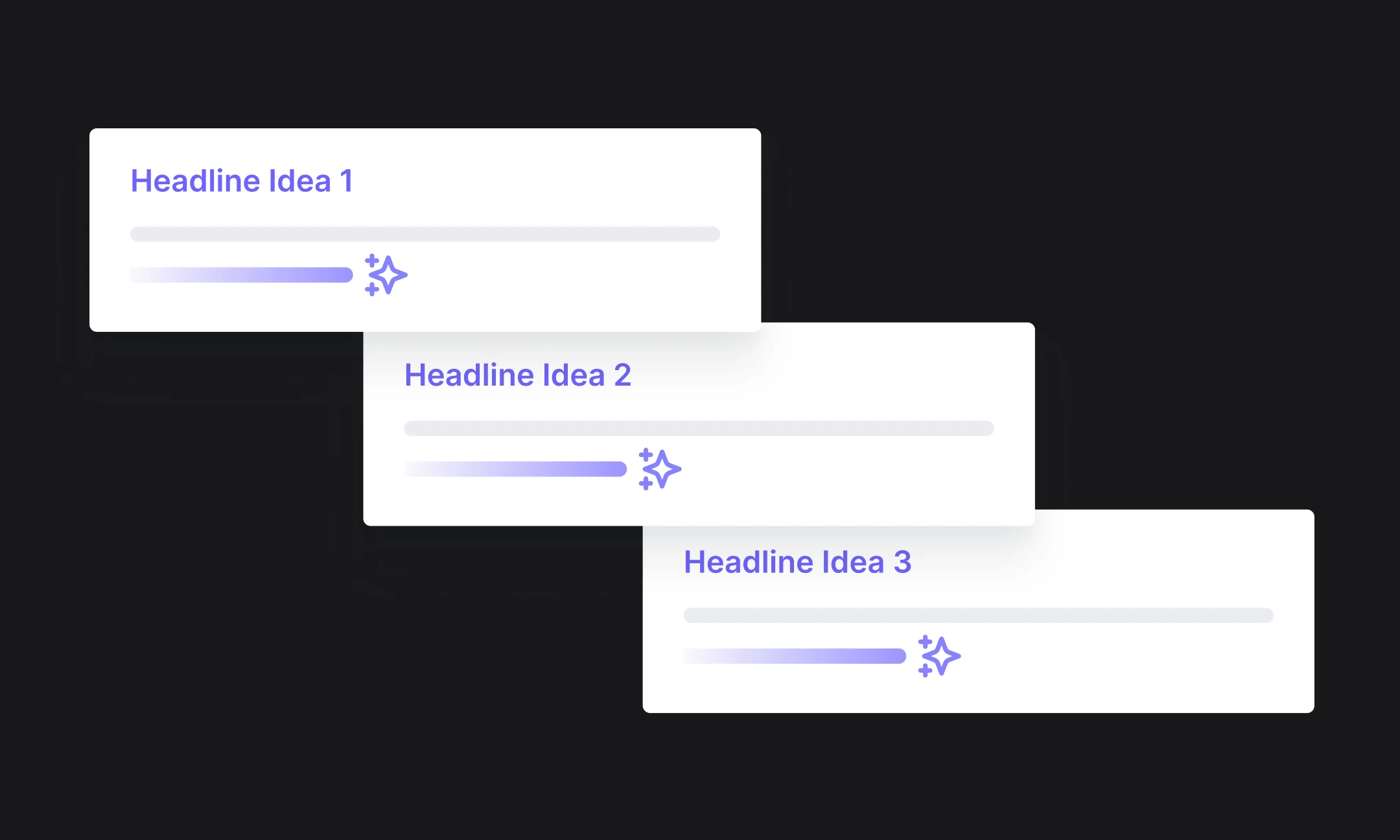Generate compelling headlines instantly.
Describe your topic and keyword

Select your favourite title

Brainstorm more headlines

Títulos llamativos al alcance de la mano
Títulos geniales escritos por nuestro generador de titulares de artículos de IA
First impressions last. Great titles are clear, succinct, and straightforward. They evoke the interest of the reader, set the tone for the rest of the article, and tell the reader what they can expect from the article without over-promising or under-delivering.
If you need some inspiration, here are some of examples of strong titles that our headline generator tool has produced that are sure to capture the attention of your target audience.








Preguntas frecuentes
What is a headline generator?
A headline generator is a type of software that helps you create headlines for your articles or blog posts. It can be a great tool to help you come up with new and interesting headlines, especially if you're struggling to come up with something that's catchy and attention-grabbing. Previous versions of headline generators used templates, which would provide you with a selection of pre-determined headlines to choose from. However, the best use of headline generators now is through the use of AI, which can create custom headlines for you based on the content of your article.
What's considered a catchy headline?
There's no one-size-fits-all answer to this question, as the definition of a catchy headline can vary depending on who you ask. However, a good rule of thumb is to think about how you can hook your readers and pique their interest from the get-go. One way to create a catchy headline is to be creative and try to come up with a original angle. You can also make use of puns, alliteration, or rhyming words to make your headline stand out. Additionally, it's important to make sure your headline is clear and concise, and that it accurately reflects the content of your article. Ultimately, it's up to you to decide what makes a good headline, but keeping the above tips in mind should help you create something that readers will want to click on.
How do you write a headline?
There's no one-size-fits-all answer to this question, as the best way to write a headline depends on the specific content and target audience of your article. However, there are a few general tips to keep in mind when writing headlines: 1. Make sure your headline is catchy and interesting. Your headline should capture the reader's attention and make them want to learn more about your article. Try to avoid boring or generic headlines, and think outside the box to come up with something unique and eye-catching. 2. Make sure your headline is relevant to your content. Your headline should accurately reflect the topic of your article. If readers click on your article expecting one thing, but they find something completely different when they start reading, they're going to be disappointed � and might not come back for future articles. 3. Make sure your headline is easy to understand. Your headline should be clear and concise, giving readers a brief overview of what the article is about without being too wordy or confusing. Try to use simple, everyday language that most people will be able to understand.
Is a title the same as a headline?
There is definitely some overlap between titles and headlines, but they're not exactly the same. Titles are typically used when talking about a book, article, or other piece of writing, while headlines are used when talking about news stories or blog posts. That said, the line between them can be blurry. For example, a headline might also be the title of an article, or a title might be used as the headline for a blog post. And sometimes newspapers will use a headline for an article on the front page, and then use the title of the article for the byline on the inside pages. Overall, though, titles and headlines generally have different purposes. Titles are meant to give readers a sense of what the piece is about, while headlines are meant to grab people's attention and make them want to read more.
Is Hypotenuse AI's headline generator free?
Yes, Hypotenuse AI's headline generator is free to use during our 7-day free trial. You can generate an unlimited number of headlines using the tool, and there are no restrictions on how you can use them. However, if you want to generate more than the words given to you for the trial, you'll need to purchase a plan.
Los beneficios de un gran titular
¿Por qué son importantes los titulares de los artículos?
Al igual que a menudo juzgamos los libros por su portada, juzgamos los sitios web/artículos por sus títulos y titulares.
De hecho, su título podría ser la única razón por la que su sitio web no está alcanzando su máximo potencial. Sólo con hacer algunos cambios en su titular, puede aumentar el tráfico de su sitio hasta en un 500%.
Cuando se crea un sitio web, se desea que más personas lo visiten e interactúen con su contenido. Cuanto más comprometida y de mayor volumen sea su audiencia, más probable será que su sitio crezca y prospere.
Los títulos ocupan un lugar exclusivo en el contenido que usted presenta a un lector y los lectores suelen decidir si deben o no hacer clic en el enlace o quedarse justo después de leer el título.
Esto significa que el título puede ser su única oportunidad de causar una primera impresión duradera, por lo que es importante que sea fuerte. Escribe un título que muestre la mejor versión de tu artículo y atraiga la atención del lector.
¿Qué hace que un titular sea bueno y pegadizo?
Creemos que un título sólido debe ser sencillo, informativo y directo. Esto significa condensar eficazmente la esencia del artículo para que su público objetivo sepa qué esperar y si vale la pena leer el artículo o no.
Los mejores títulos son llamativos y convincentes, pero no son spam ni clickbaity. Establece el tono adecuado para el artículo y utiliza una selección de palabras muy deliberada y precisa. Por ejemplo, un título más desenfadado con palabras informales sienta un precedente para un artículo más conversacional o divertido, mientras que un título más serio allana el camino para un artículo más académico y erudito.
He aquí algunos ejemplos de titulares eficaces:
1. "Cómo usar un generador de titulares para escribir mejores titulares"
2. "3 sencillos consejos para escribir titulares eficaces"
3. "Cómo hacer que tus titulares sean más amigables con el SEO"
4. "5 formas de hacer que tus titulares sean más atractivos"
¿Qué se puede hacer para que un titular sea más convincente?
¿Cuánto tráfico está perdiendo por su título? Resulta que el 80% de la gente lee el título, pero sólo el 20% hace clic en él, lo que significa que el título es fundamental para la visualización y el tráfico de un artículo.
Si quieres aprender a escribir títulos impactantes que impulsen la participación, sigue leyendo. Compartiremos consejos sobre cómo escribir titulares y títulos potentes.
- Sea específico y relevante: Asegúrese de que su titular es específico para el artículo que está escribiendo y que representa con precisión el contenido.
- Utilice palabras clave exactas: El uso de palabras clave en su titular puede anclar el tema en la mente de su lector, y también mejorar su clasificación SEO señalando la relevancia para el motor de búsqueda.
- Sea breve: los titulares deben tener entre 6 y 8 palabras para obtener los mejores resultados (y evitar que se corten en los resultados de búsqueda).
- Use numbers and statistics: Numerals against a line of text stand out, making your headline more eye-catching. Instead of writing a headline with the words “five ways”, write a headline with the words “5 ways”.
People naturally gravitate towards specific statistics, which also make you sound more credible and trustworthy.
- Cree una sensación de urgencia: Si es posible, intente crear una sensación de urgencia o emoción en su titular para animar a los lectores a hacer clic.
- Brainstorm, brainstorm, brainstorm!: To make sure your article ranks well and your headline is clickable, maximize your chances by brainstorming a variety.
Try writing a dozen or more headlines before choosing the best. If you’re having trouble coming up with that many headlines, maybe our headline generator can help.
¿Qué longitud debe tener un titular?
Los títulos deben ser lo suficientemente largos como para comunicar eficazmente la esencia del artículo, pero lo suficientemente cortos como para que no se corten en las SERP y no sean demasiado extensos. ¿La longitud ideal? Los estudios demuestran que es de unos 60 caracteres.




















